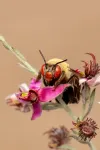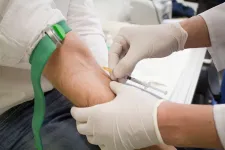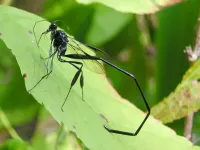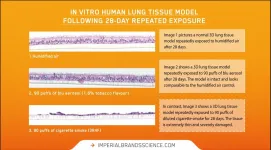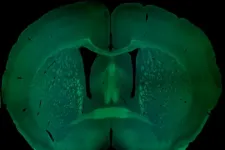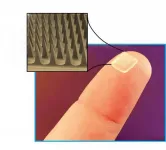Mysterious hydrogen-free supernova sheds light on stars' violent death throes
2021-05-05
(Press-News.org) A curiously yellow pre-supernova star has caused astrophysicists to re-evaluate what's possible at the deaths of our Universe's most massive stars. The team describe the peculiar star and its resulting supernova in a new study published today in Monthly Notices of the Royal Astronomical Society.
At the end of their lives, cool, yellow stars are typically shrouded in hydrogen, which conceals the star's hot, blue interior. But this yellow star, located 35 million light years from Earth in the Virgo galaxy cluster, was mysteriously lacking this crucial hydrogen layer at the time of its explosion.
"We haven't seen this scenario before," said Charles Kilpatrick, postdoctoral fellow at Northwestern University's Center for Interdisciplinary Exploration and Research in Astrophysics (CIERA), who led the study. "If a star explodes without hydrogen, it should be extremely blue -- really, really hot. It's almost impossible for a star to be this cool without having hydrogen in its outer layer. We looked at every single stellar model that could explain a star like this, and every single model requires that the star had hydrogen, which, from its supernova, we know it did not. It stretches what's physically possible."
Kilpatrick is also a member of the Young Supernova Experiment, which uses the Pan-STARRS telescope at Haleakalā, Hawaii to catch supernovae right after they explode. After the Young Supernova Experiment spotted supernova 2019yvr in the relatively nearby spiral galaxy NGC 4666, the team used deep space images captured by NASA's Hubble Space Telescope, which fortunately already observed this section of the sky two and a half years before the star exploded.
"What massive stars do right before they explode is a big unsolved mystery," Kilpatrick said. "It's rare to see this kind of star right before it explodes into a supernova."
The Hubble images show the source of the supernova, a massive star imaged just a couple of years before the explosion. Several months after the explosion however, Kilpatrick and his team discovered that the material ejected in the star's final explosion seemed to collide with a large mass of hydrogen. This led the team to hypothesize that the progenitor star might have expelled the hydrogen within a few years before its death.
"Astronomers have suspected that stars undergo violent eruptions or death throes in the years before we see supernovae," Kilpatrick said. "This star's discovery provides some of the most direct evidence ever found that stars experience catastrophic eruptions, which cause them to lose mass before an explosion. If the star was having these eruptions, then it likely expelled its hydrogen several decades before it exploded."
In the new study, Kilpatrick's team also presents another possibility: a less massive companion star might have stripped away hydrogen from the supernova's progenitor star. However, the team will not be able to search for the companion star until after the supernova's brightness fades, which could take up to a decade.
"Unlike its normal behaviour right after it exploded, the hydrogen interaction revealed it's kind of this oddball supernova," Kilpatrick said. "But it's exceptional that we were able to find its progenitor star in Hubble data. In four or five years, I think we will be able to learn more about what happened."
INFORMATION:
[Attachments] See images for this press release:

ELSE PRESS RELEASES FROM THIS DATE:
2021-05-05
How can a highly effective drug be transported to the precise location in the body where it is needed? In the journal Angewandte Chemie, chemists at Heinrich Heine University Düsseldorf (HHU) together with colleagues in Aachen present a solution using a molecular cage that opens through ultrasonification.
Supramolecular chemistry involves the organization of molecules into larger, higher-order structures. When suitable building blocks are chosen, these systems 'self-assemble' from their individual components.
Certain supramolecular compounds are well suited for 'host-guest chemistry'. In such cases, a host structure encloses a guest molecule and can shield, protect and transport it away from its environment. This is a specialist field of Dr. Bernd M. Schmidt and ...
2021-05-05
The United States-Mexico border traverses through large expanses of unspoiled land in North America, including a newly discovered worldwide hotspot of bee diversity. Concentrated in 16 km2 of protected Chihuahuan Desert are more than 470 bee species, a remarkable 14% of the known United States bee fauna.
This globally unmatched concentration of bee species is reported by Dr. Robert Minckley of the University of Rochester and William Radke of the United States Fish and Wildlife Service in the open-access, peer-reviewed Journal of Hymenoptera Research.
Scientists studying native U.S. bees have long recognized that the Sonoran and Chihuahuan deserts of North America, home to species with interesting life histories, have high bee biodiversity. Exactly how many species ...
2021-05-05
Sanaria® PfSPZ-CVac" is a live vaccine consisting of infectious Plasmodium falciparum (Pf) malaria parasites that are injected into the subject at the same time as they receive an antimalarial drug. The parasites quickly enter the liver where they develop and multiply for 6 days, and then emerge into the blood As soon as the parasites leave the liver, the drug kills them immediately. Thus, the immune system of the vaccinated subject is primed against many parasite proteins and becomes highly effective at killing malaria parasites in the liver to block infection and prevent disease.
"With this study, we have reached a new important milestone in the development of an effective malaria vaccine. With only three immunizations over four weeks, we achieved very good protection ...
2021-05-05
Daniel Redhead, from the Max Planck Institute for Evolutionary Anthropology, and Chris von Rueden, from the University of Richmond, published a new study that describes coalition formation among men in Tsimané Amerindians living in Amazonian Bolivia, over a period of eight years. In two Tsimané communities, the authors describe the inter-personal conflicts that tend to arise between men, and the individual attributes and existing relationships that predict the coalitional support men receive in the event of conflicts.
Conflicts that arise between men concern disputes over access to forest for slash-and-burn horticulture, as well as accusations of theft, laziness, negligence, ...
2021-05-05
In about a quarter of patients with hereditary diseases, the cause of the disease remains unclear even after extensive genetic testing. One reason is that we still do not know enough about the function of many genes. Of the 30,000 known genes, just a little more than 4,000 have been found to be associated with hereditary diseases.
At the Department of Clinical Genetics of the University of Tartu Institute of Clinical Medicine, under the leadership of Professor Katrin Õunap, patients with hereditary diseases of unclear cause have been studied in various research projects since 2016. In collaboration with the Broad Institute of MIT and Harvard, these patients have undergone extensive genome-wide sequencing analyses at the level of the exome (the sequence of all genes), ...
2021-05-05
Knowing what species live in which parts of the world is critical to many fields of study, such as conservation biology and environmental monitoring. This is also how we can identify present or potential invasive and non-native pest species. Furthermore, summarizing what species are known to inhabit a given area is essential for the discovery of new species that have not yet been known to science.
For less well-studied groups and regions, distributional species checklists are often not available. Therefore, a series of such checklists is being published in the open-access, peer-reviewed Journal of Hymenoptera Research, in order ...
2021-05-05
5 May 2021, Bristol - In one of the most advanced applications of in-vitro 3D human lung models in vape research to date, a new peer-reviewed Imperial Brands study shows that, unlike combustible cigarette smoke, blu aerosol had little to no impact on numerous toxicological endpoints under the conditions of test using laboratory models.
Published in the journal Current Research in Toxicology, the experiments compared the toxicological responses of an in vitro 3D lung model (MucilAir™ from Epithelix) after repeated exposure to undiluted whole blu aerosol (1.6% tobacco flavour) or diluted whole cigarette smoke (3R4F Kentucky Reference) over a 28-day period.
After repeatedly exposing the model to ...
2021-05-05
Announcing a new article publication for BIO Integration journal. In this editorial the authors Hui Liu and Juan Chen from Shanxi Eye Hospital, Taiyuan, China discuss biophotonics in photomedicine.
As a cross-disciplinary field, biophotonics is a natural platform for innovation, e.g. researchers have taken advantages of the recently developed nanostructures in Photomedicine to optimize imaging signals and improve drug delivery efficiency. Active investment in healthcare also contributes to the quick clinical transitions of biophotonic innovations.
However, to genuinely and successfully improve people's lives, many gaps have to be bridged. Horizontally, ...
2021-05-05
After reviewing a database of gene mutations in children with autism spectrum disorder (ASD), a team of Medical University of South Carolina (MUSC) researchers decided to study a specific gene mutation that likely caused ASD in a girl. They demonstrated that the mutation was damaging to the gene, and that female, but not male, mice lacking a working copy of the gene also showed ASD-associated symptoms. Better understanding the interplay between genetics and sex in ASD could set the stage for developing sex-specific treatments for autism.
The MUSC team was led by Christopher Cowan, Ph.D., the William E. Murray SmartState Endowed Chair in Neuroscience and chair of the Department of Neuroscience, and Ahlem Assali, Ph.D., research assistant ...
2021-05-05
A recent study from the University of Helsinki monitors the breakthrough progresses in the development of microneedles for immunotherapy and discusses the challenges regarding their production. Researchers suggest using microneedles for immunotherapy due to the high abundance of immune cells under the skin. The aim is to vaccinate or treat different diseases, such as cancer and autoimmune disorders, with minimal invasiveness and side effects.
"Our study addresses the recent achievements in the development of microneedles for immunotherapy of hard-to-treat and chronic diseases to achieve the highest efficiency with minimal side effects," says ...
LAST 30 PRESS RELEASES:
[Press-News.org] Mysterious hydrogen-free supernova sheds light on stars' violent death throes


